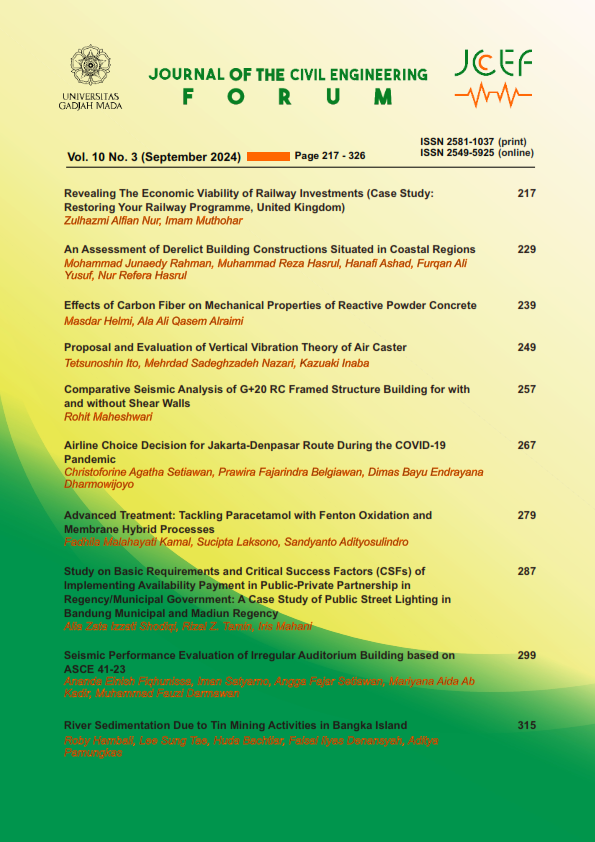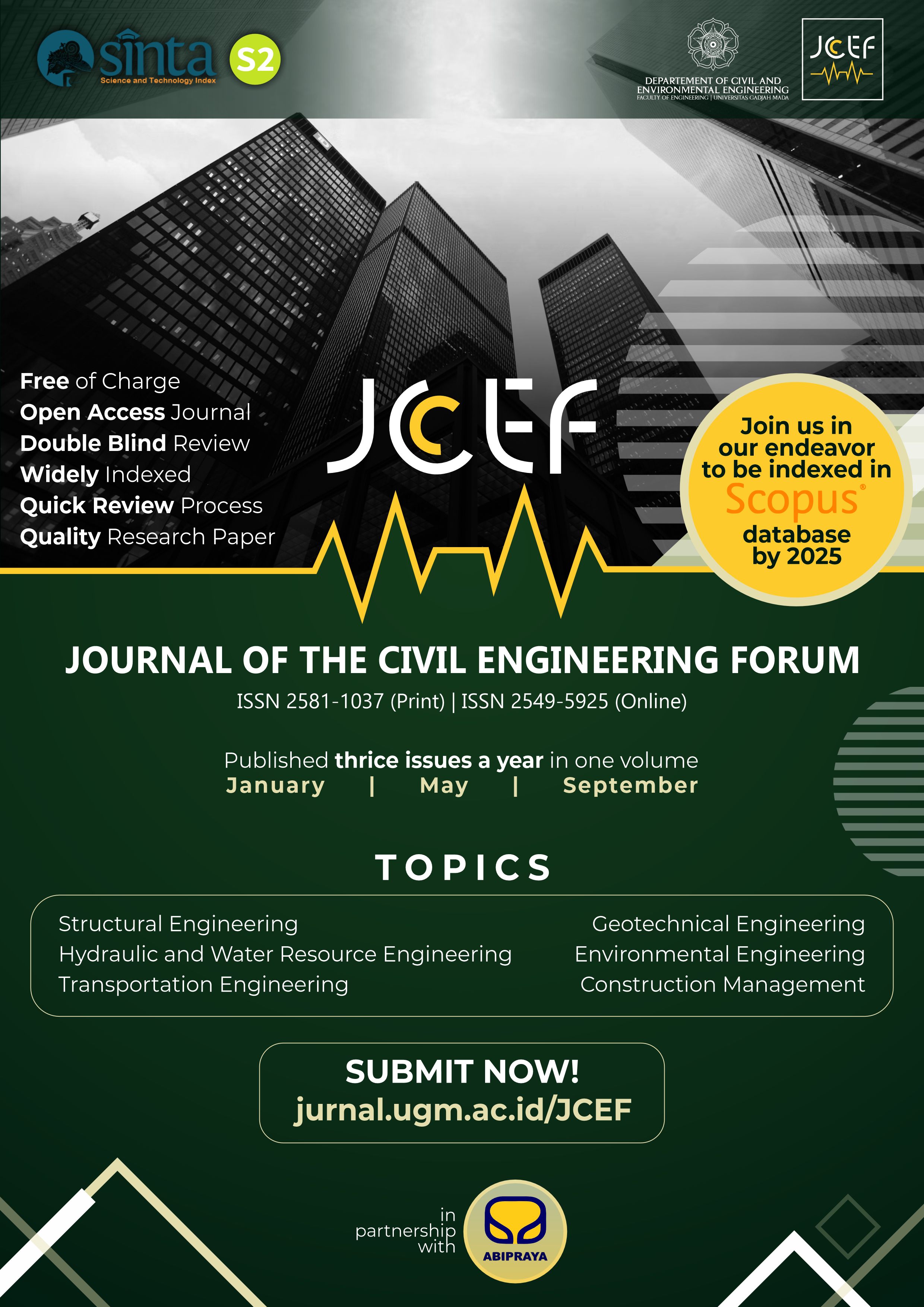Advanced Treatment: Tackling Paracetamol with Fenton Oxidation and Membrane Hybrid Processes
Abstract
Paracetamol (PCT) in aquatic environments has become a global concern due to its potential harm to humans and environments. However, conventional water treatment was only able to degrade PCT partially. It was necessary to treat PCT contaminated water with tertiary technologies in particular by combination approach, such as Fenton oxidation and membrane filtration process. This combined approach enabling mitigation of large chemical footprint and iron residue associated with Fenton oxidation, as well as reducing fouling tendency of the membrane. The aim of this study was to evaluate the PCT removal efficiency by hybrid technology Fenton oxidation and membrane filtration. The membrane performance during the filtration process was also analyzed. As an important parameter for Fenton process, concentration of H 2 O 2 /Fe 2+ with ratio of 1:0.5 resulted in optimal removal of 45% PCT in terms of COD removal. However, separation using flat sheet Polyethersulfone Ultrafiltration (UF) with constant flux of 120 L/m²·h resulted in insignificant of COD removal. Nevertheless, the UF process was able to remove up to 54% of Fe 2+ at pH in alkaline condition with 8.5. In addition, a decrease in membrane permeability down to 0.2 L/m²h/bar over time, according to the filtered specific volume during the UF process, indicates fouling of the UF membrane during the 120 minutes of filtration. While the combined approach does not show significant improvement in COD removal, it does help to reduce the chemical footprint of the process, which is an important factor for the applicability of the selected water treatment method.
References
Abdelrasoul, A., Doan, H. and Lohi, A. (2013), Fouling in membrane filtration and remediation methods, in ‘Mass Transfer - Advances in Sustainable Energy and Environment Oriented Numerical Modeling’, InTech. URL: https://doi.org/10.5772/52370
Adityosulindro, S., Julcour, C. and Barthe, L. (2018), ‘Heterogeneous fenton oxidation using fe-zsm5 catalyst for removal of ibuprofen in wastewater’, Journal of Environmental Chemical Engineering 6(5), 5920–5928. URL: https://doi.org/10.1016/j.jece.2018.09.007
Ahmed, M., Amin, S. and Mohamed, A. (2023), ‘Fouling in reverse osmosis membranes: monitoring, characterization, mitigation strategies and future directions’, Heliyon 9(4), e14908. URL: https://doi.org/10.1016/j.heliyon.2023.e14908
Alessandretti, I., Rigueto, C., Nazari, M., Rosseto, M. and Dettmer, A. (2021), ‘Removal of diclofenac from wastewater: A comprehensive review of detection, characteristics and tertiary treatment techniques’, Journal of Environmental Chemical Engineering 9(6), 106743. URL: https://doi.org/10.1016/j.jece.2021.106743
Alqaheem, Y. and Alomair, A. (2020), ‘Microscopy and spectroscopy techniques for characterization of polymeric membranes’, Membranes 10(2), 33. URL: https://doi.org/10.3390/membranes10020033
AlSawaftah, N., Abuwatfa, W., Darwish, N. and Husseini, G. (2021), ‘A comprehensive review on membrane fouling: Mathematical modelling, prediction, diagnosis, and mitigation’, Water 13(9), 1327. URL: https://doi.org/10.3390/w13091327
Arahman, N., Jakfar, J., Dzulhijjah, W., Halimah, N., Silmina, S., Aulia, M., Fahrina, A. and Bilad, M. (2022), ‘Hydrophilic antimicrobial polyethersulfone membrane for removal of turbidity of well-water’, Water 14(22), 3769. URL: https://doi.org/10.3390/w14223769
Ganiyu, S., van Hullebusch, E., Cretin, M., Esposito, G. and Oturan, M. (2015), ‘Coupling of membrane filtration and advanced oxidation processes for removal of pharmaceutical residues: A critical review’, Separation and Purification Technology 156, 891–914. URL: https://doi.org/10.1016/j.seppur.2015.09.059
Hove, M., van Hille, R. and Lewis, A. (2008), ‘Mechanisms of formation of iron precipitates from ferrous solutions at high and low ph’, Chemical Engineering Science 63(6), 1626–1635. URL: https://doi.org/10.1016/j.ces.2007.11.016
Husain Khan, A., Abdul Aziz, H., Palaniandy, P., Naushad, M., Cevik, E. and Zahmatkesh, S. (2023), ‘Pharmaceutical residues in the ecosystem: Antibiotic resistance, health impacts, and removal techniques’, Chemosphere 339, 139647. URL: https://doi.org/10.1016/j.chemosphere.2023.139647
Islam, M. A., Nazal, M., Sajid, M. and Suliman, M. A. (2024), ‘Adsorptive removal of paracetamol from aqueous media: A review of adsorbent materials, adsorption mechanisms, advancements, and future perspectives’, Journal of Molecular Liquids 396, 123976. URL: https://doi.org/10.1016/j.molliq.2024.123976
Koagouw, W., Arifin, Z., Olivier, G. and Ciocan, C. (2021), ‘High concentrations of paracetamol in effluent dominated waters of jakarta bay, indonesia’, Marine Pollution Bulletin 169, 112558. URL: https://doi.org/10.1016/j.marpolbul.2021.112558
Kuttiani Ali, J., Abi Jaoude, M. and Alhseinat, E. (2021), ‘Polyimide ultrafiltration membrane embedded with reline-functionalized nanosilica for the remediation of pharmaceuticals in water’, Separation and Purification Technology 266, 118585. URL: https://doi.org/10.1016/j.seppur.2021.118585
Li, Y., Gong, X., Sun, Y., Shu, Y., Niu, D. and Ye, H. (2022), ‘High molecular weight fractions of dissolved organic matter (dom) determined the adsorption and electron transfer capacity of dom on iron minerals’, Chemical Geology 604, 120907. URL: https://doi.org/10.1016/j.chemgeo.2022.120907
MacKeown, H., Benedetti, B., Scapuzzi, C., Di Carro, M. and Magi, E. (2022), ‘A review on polyethersulfone membranes in polar organic chemical integrative samplers: Preparation, characterization and innovation’, Critical Reviews in Analytical Chemistry pp. 1–17. URL: https://doi.org/10.1080/10408347.2022.2131374
Mirzaei, A., Chen, Z., Haghighat, F. and Yerushalmi, L. (2017), ‘Removal of pharmaceuticals from water byhomo/heterogonous fenton-type processes – a review’, Chemosphere 174, 665–688. URL: https://doi.org/10.1016/j.chemosphere.2017.02.019
Nandiyanto, A., Oktiani, R. and Ragadhita, R. (2019), ‘How to read and interpret ftir spectroscope of organic material’, Indonesian Journal of Science and Technology 4(1), 97. URL: https://doi.org/10.17509/ijost.v4i1.15806
Pacheco-Álvarez, M., Picos Benítez, R., RodríguezNarváez, O., Brillas, E. and Peralta-Hernández, J. (2022), ‘A critical review on paracetamol removal from different aqueous matrices by fenton and fenton-based processes, and their combined methods’, Chemosphere . URL: https://doi.org/10.1016/j.chemosphere.2022.134883
Phong Vo, H., Le, G., Hong Nguyen, T., Bui, X.-T., Nguyen, K., Rene, E., Vo, T., Thanh Cao, N.-D. and Mohan, R. (2019), ‘Acetaminophen micropollutant: Historical and current occurrences, toxicity, removal strategies and transformation pathways in different environments’, Chemosphere 236, 124391. URL: https://doi.org/10.1016/j.chemosphere.2019.124391
Rosman, N., Salleh, W., Mohamed, M., Jaafar, J., Ismail, A. and Harun, Z. (2018), ‘Hybrid membrane filtrationadvanced oxidation processes for removal of pharmaceutical residue’, Journal of Colloid and Interface Science 532, 236–260. URL: https://doi.org/10.1016/j.jcis.2018.07.118
Sychev, A. and Isak, V. (1995), ‘Iron compounds and the mechanisms of the homogeneous catalysis of the activation of o 2 and h 2 o 2 and of the oxidation of organic substrates’, Russian Chemical Reviews 64(12), 1105–1129. URL: https://doi.org/10.1070/RC1995v064n12ABEH000195
Van, H., Nguyen, L., Hoang, T., Nguyen, T., Tran, T., Nguyen, T., Vu, X., Pham, M., Tran, T., Pham, T. et al. (2020), ‘Heterogeneous fenton oxidation of paracetamol in aqueous solution using iron slag as a catalyst: Degradation mechanisms and kinetics’, Environmental Technology & Innovation 18, 100670. URL: https://doi.org/10.1016/j.eti.2020.100670
Ziembowicz, S. and Kida, M. (2022), ‘Limitations and future directions of application of the fenton-like process in micropollutants degradation in water and wastewater treatment: A critical review’, Chemosphere 296, 134041. URL: https://doi.org/10.1016/j.chemosphere.2022.134041
Copyright (c) 2024 The Author(s)

This work is licensed under a Creative Commons Attribution-ShareAlike 4.0 International License.
Copyright is granted to authors for the purpose of providing protection for articles written to describe experiments and their results. JCEF will protect and defend the work and reputation of the author and are also willing to address any allegations of violation, plagiarism, fraud, etc. against articles written and published by JCEF. JCEF is published under the terms of the Creative Commons Attribution-ShareAlike 4.0 International License (CC BY-SA 4.0). The author holds the copyright and assigns the journal rights to the first publication (online and print) of the work simultaneously.




